Table of Contents
One of the first devices used after the gold pan was the gold rocker box. The rocker allowed small operators to increase the amount of gravel handled in a shift, with a minimum investment in equipment. Rockers vary in size, shape, and general construction, depending upon available construction materials, size of gold recovered, and the builder’s mining experience. Gold Rocker Boxes generally ranged in length from 24 to 60 inches, in width from 12 to 25 inches, and in height from 6 to 24 inches. Resembling a box on skids or a poorly designed sled, a rocker sorts materials through screens. (Figure 1).
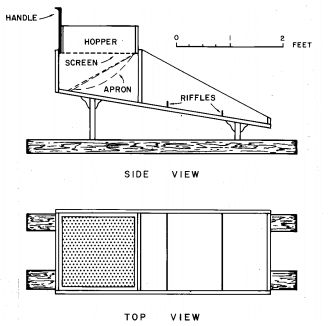 Rockers are built in three distinct parts, a body or sluice box, a screen, and an apron. The floor of the body holds the riffles in which the gold is caught. The screen catches the coarser materials and is a place where clay can be broken up to remove all small particles of gold. Screens are typically 16 to 20 inches on each side with one-half inch openings. Fine material is washed through the openings by water onto an inclined apron. The apron is used to carry all material to the head of the rocker, and is made of canvas stretched loosely over a frame. It has a pocket, or low place, in which coarse gold and black sands can be collected. The apron can be made of a variety of materials: blanket, carpet, canvas, rubber mat, burlap or amalgamated copper plate. Riffles below the apron help to collect gold before discharge.
Rockers are built in three distinct parts, a body or sluice box, a screen, and an apron. The floor of the body holds the riffles in which the gold is caught. The screen catches the coarser materials and is a place where clay can be broken up to remove all small particles of gold. Screens are typically 16 to 20 inches on each side with one-half inch openings. Fine material is washed through the openings by water onto an inclined apron. The apron is used to carry all material to the head of the rocker, and is made of canvas stretched loosely over a frame. It has a pocket, or low place, in which coarse gold and black sands can be collected. The apron can be made of a variety of materials: blanket, carpet, canvas, rubber mat, burlap or amalgamated copper plate. Riffles below the apron help to collect gold before discharge.
Show above is a portable rocker that is easily built. The six bolts are removed to dismantle the rocker for easy transportation. The material required to construct it is given in the following tabulation:
- A. End, one piece 1 in. x 14 in. x 16 in.
- B. Sides, two pieces 1 in. x 14 in. x 48 in.
- C. Bottom, one piece 1 in. x 14 in. x 44 in.
- D. Middle spreader, one piece 1 in. x 6 in. x 16 in.
- E. End spreader, one piece 1 in. x 4 in. x 15 in.
- F. Rockers, two pieces, 2 in. x 6 in. x 17 in. (shaped)
- H. Screen, about 16 in. square outside dimensions with screen bottom. Four pieces of 1 in x 4 in. x l5 1/4 in. and one piece of screen 16 in. square with 1/4 in. or 1/2 in. openings or sheet metal perforated by similar openings.
- K. Apron, made of 1 in. x 2 in. strips covered loosely with canvas. For cleats and apron, etc., 27 feet of 1 in. x 2 in. lumber is needed. Six pieces of 3/8 in. iron rod 19 in. long threaded 2 in. on each end and fitted with nuts and washers. L. The handle, placed on the screen, although some miners prefer it on the body. When on the screen, it helps in lifting the screen from the body.
If l- by 14-inch boards cannot be obtained, clear flooring tightly fitted will serve, but 12 feet of 1- by 2-inch cleats in addition to that above mentioned will be needed.
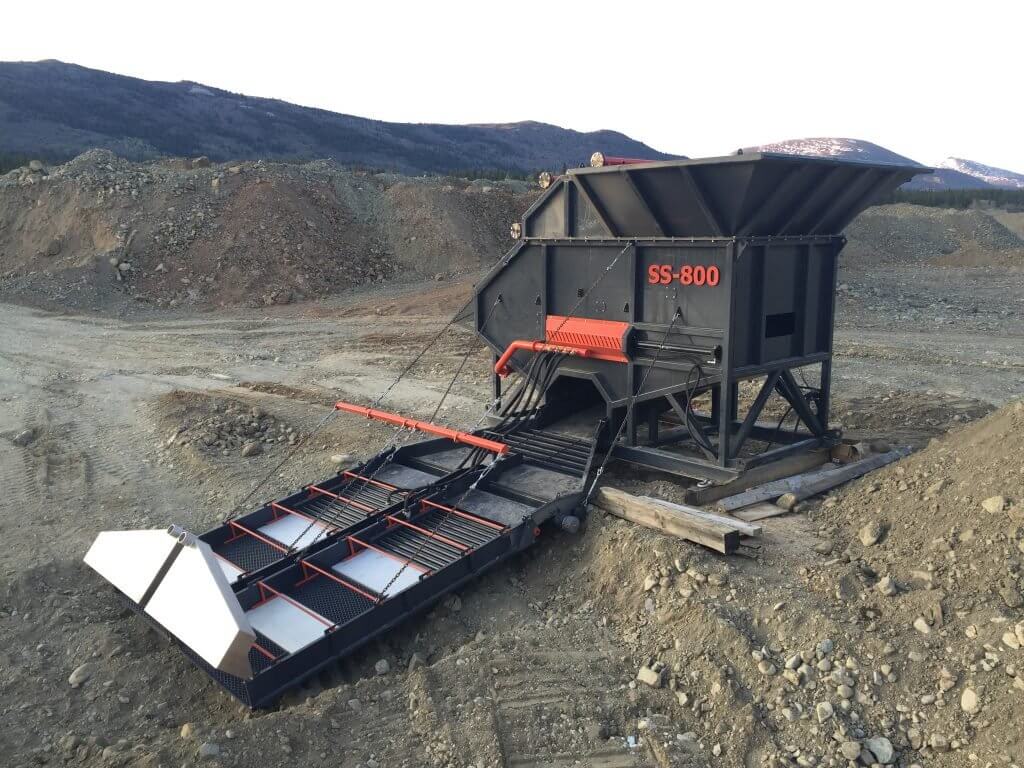
A dipper may be made of no. 2 1/2 can and 30 inches of broom handle. Through the center of each of the rockers a spike is placed to prevent slipping during operation. In constructing riffles, it is advisable to build them in such a way that they may be easily removed, so that clean-ups can be made readily. Two planks about 2 by 8 by 24 inches with a hole in the center to hold the spike in the rockers are also required. These are used as a bed for the rockers to work on and to adjust the slope of the bed of the rocker.
Assembly. The parts are cut to size as shown in Figure 2. The cleats on parts A, B, C, and D are of1- by 2-inch material and are fastened with nails or screws. The screen (H) is nailed together and the handle (L) is bolted to one side. Corners of the screen should be reinforced with pieces of sheet metal because the screen is being continually pounded by rocks when the rocker is in use. The apron (K) is a frame nailed together, and canvas is fastened to the bottom. Joints at the comers should be strengthened with strips of tin or other metal.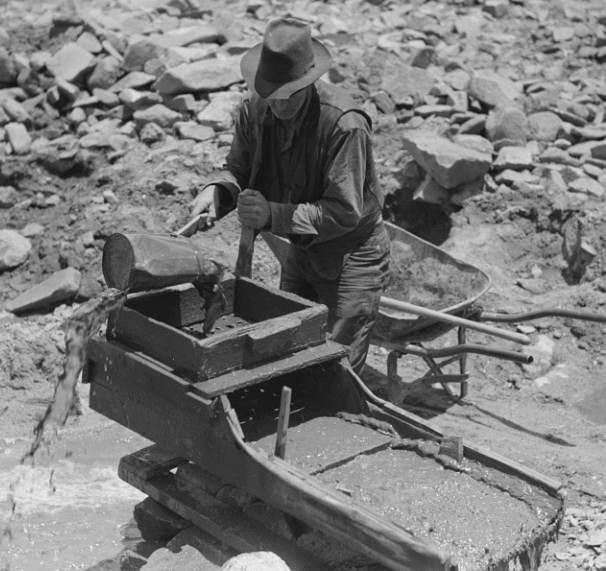
Parts are assembled as follows: place bottom (C), end (A) with cleats inside, middle spreader (D) with cleat toward A, and end spreader (E) in position between the two sides (B) as shown. Insert the six bolts and fasten the nuts. Rockers (F) should be fastened to bottom (C) with screws. Set apron (K) and screen (H) in place, and the rocker is ready for use.
If one-quarter-inch lag screws are driven into the bottom of each rocker about 5 inches from each side of the spike and the heads are allowed to protrude from the wood, a slight bump will result as the machine is worked back and forth. This additional vibration will help to concentrate the gold. If screws are used, metal strips should be fastened to the bed-plates to protect the wood.
Operation. Gravel is shoveled into the hopper and the rocker is vigorously shaken back and forth while water flows over the gravel. The slope of the rocker is important for good recovery. With coarse gold and clay-free gravel, the head bed plate should be 2 to 4 inches higher than the tail bed plate. If the material is clayey, or if fine gold is present, lessen the slope to perhaps only an inch.
The rate of water flow is also important. Too much water will carry the gold through the rocker without settling, and too little will form a mud that will carry away fine gold. Water may be dipped in by hand, or fed with a hose or pipe (Photo 2). It is important to maintain a steady flow of water through the rocker. When all the material that can pass through the screen has done so, the screen is dumped and new material added and washed. The process continues until it is necessary to clean the apron. Frequent cleanups, on the order of several times a day, are necessary for maximum recovery.
For cleanup, the apron is removed and carefully washed in a tub. The riffles are cleaned less frequently, whenever sand buildup is heavy. After cleanup, the rocker is reassembled and processing resumed. The collected concentrates are further refined, usually by amalgamation or panning. Mercury is sometimes added to the riffles to collect fine gold.
Two people operating a rocker and using 100-800 gallons of water can process 3 to 5 cubic yards of material in 10 hours. The capacity of rockers may be increased by using a power drive set for forty 6-inch strokes per minute. A power rocker operated by two men can process 1 to 3 cubic yards of material per hour. The rocker is an improvement over the gold pan, but is limited by the need for frequent cleanups and poor fine- gold recovery. Rockers are not widely used today.
Gold Cradle
At least twice as much gravel can be worked per day with the rocker as with the pan. The rocker or cradle, as it is sometimes called, must be manipulated carefully to prevent loss of fine gold. With the rocker, the manual labor of washing is less strenuous, but whether panning or rocking, the same method is used for excavating the gravel.
The rocker, like the pan, is used extensively in small-scale placer work, in sampling, and for washing sluice concentrates and material cleaned by hand from bedrock in other placer operations. One to three cubic yards, bank measure, can be dug and washed in a rocker per man-shift, depending upon the distance the gravel or water has to be carried, the character of the gravel, and the size of the rocker. Rockers are usually homemade and display a variety of designs. A favorite design consists essentially of a combination washing box and screen, a canvas or carpet apron under the screen, a short sluice with two or more riffles, and rockers under the sluice (fig. 3) . The bottom of the washing box consists of sheet metal with holes about ½ inch in diameter punched in it, or a ½-inch-mesh screen can be used. Dimensions shown are satisfactory but variations are possible. The bottom of the rocker should be made of a single wide, smooth board, which will greatly facilitate cleanups. The materials for building a rocker cost only a few dollars, depending mainly upon the source of lumber.
After being dampened, the gravel is placed in the box, one or two shovelfuls at a time. Water is then poured on the gravel while the rocker is swayed back and forth. The water usually is dipped up in a simple long-handled dipper made by nailing a tin can to the end of a stick. A small stream from a pipe or hose may be used if available. The gravel is washed clean in the box, and the oversize material is inspected for nuggets, then dumped out. The undersize material goes over the apron, where most of the gold is caught. Care should be taken that not too much water is poured on at one time, as some of the gold may be flushed nut. The riffles stop any gold that gets over the apron. In regular mining work, the rocker is cleaned up after every 2 to 3 hours, or
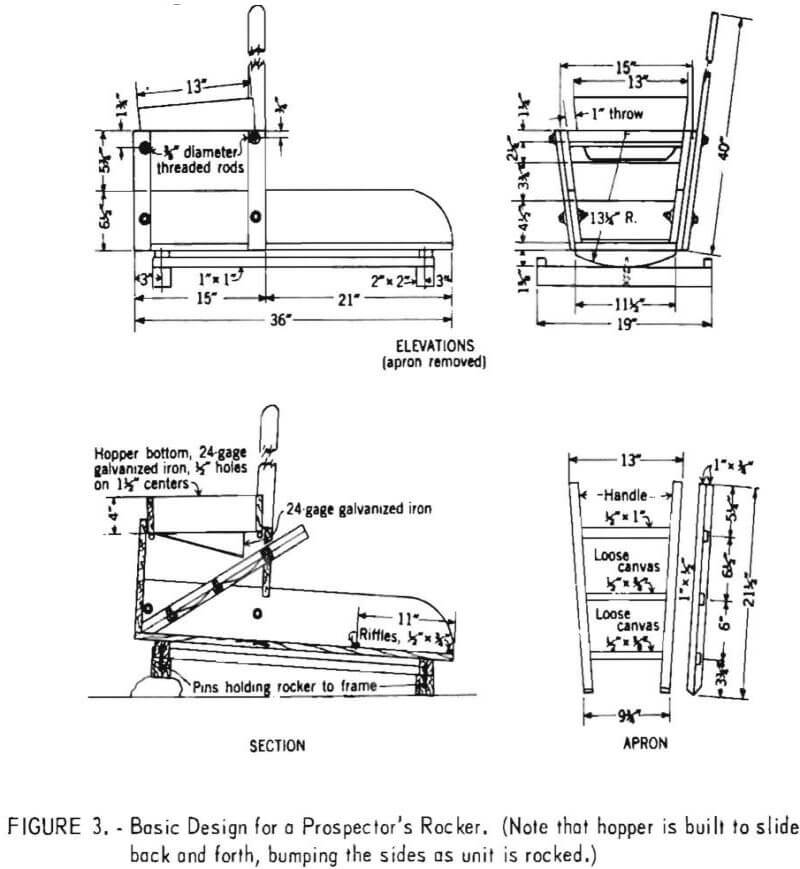
oftener when rich ground is worked and gold begins to show on the apron or in the riffles. In cleaning up after a run, water is poured through while the washer is gently rocked, and the top surface sand and dirt are washed away. Then the apron is dumped into a pan. The material back of the riffles in the sluice is taken up by a flat scoop, placed at the head of the sluice, and washed down gently once or twice with clear water. The gold remains behind on the boards, from which it is scraped up and put into the pan with the concentrate from the apron. The few colors left in the sluice will be caught with the next run. The concentrate is cleaned in the pan.
Skillful manipulation of the rocket and a careful cleanup permit recovery of nearly all the gold. Violent rocking should be avoided, so that gold will not splash out of the apron or over the riffles. The sand behind the riffles should be stirred occasionally, if it shows a tendency to pack hard, to prevent loss of gold. If the gravel is very clayey it may be necessary to soak it for some hours in a tub of water before rocking it.
Where water is scarce, two small reservoirs are constructed, one in front and the other to the rear of the rocker. The reservoir at the front serves as a settling basin. The overflow drains back to the one at the rear, and the water is used over again.
The capacity of rockers may be increased by using power drives. Such a device might be rocked by an eccentric arm at the rate of approximately forty 6-inch strokes per minute. The capacity of the typical machine with two men working is 1 cubic yard per hour. Where gravel is free from clay, the capacity may be as great as 3 cubic yards per hour. The cost of the mechanized rocker and a secondhand engine for driving it is estimated at $400.
Gold Rocker Box Design

Rockers are widely used for washing placer samples and under most conditions they are well suited to the needs of the field engineer. It should be noted that since its inception, the American gold dredging industry has, for the most part, used rockers in preference to other types of sample washing equipment. The fact that the rocker has survived in direct competition with a variety of more “modern” or “improved” machines which have been introduced over the years attests to the reliability of results which can be obtained.
Rockers are usually homemade and are built in a variety of sizes and designs depending on the ideas and experience of the builder. Figure 18 shows a lightweight rocker which is easily built and is suitable for general use. Individual components are a screen-bottomed hopper for receiving and sizing the feed material, a canvas apron for deflecting the feed to the head-end of the rocker, the rocker body which is equivalent to a sluice, and a bed plate or frame upon which the entire assembly is mounted. A rocker may be made any convenient size because within limits, its size will determine throughput capacity rather than its efficiency as a gold saver. Although there are no fixed size criteria, a rocker 1 foot wide by 3 feet long would generally be referred to as “small” and one more than 18 inches wide or 5 feet long as “large.” When made of wood (which is usually the case) clear lumber without cracks or flaws must be used and the bottom should be made of vertical-grained stock which will not shred or rough-up when scraped. Heavy-duty rockers and those which are in continuous use are preferably made of sugar pine reinforced with suitable metal fittings. Where sugar pine is not available, redwood makes a fair substitute. Rockers made of exterior grade plywood have the advantage of lighter weight and they are strong and durable if the joints are sealed with waterproof glue. The exposed surfaces of a plywood rocker should be protected with marine varnish or spar.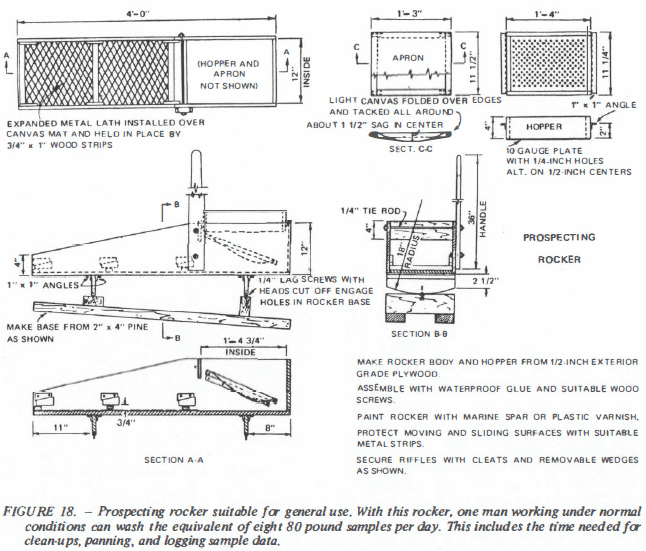
The hopper should be made ½ to ¾-inch narrower than the inside width of the rocker; this results in a bumping action as the rocker is operated and assists scouring and screening the gravel. The amount of open area in the screen plate is important. A screen with too much open area allows the fines to pass through too fast and where much sand is present this can cause overloading of the riffles with resultant gold loss. A plate with ¼-inch holes drilled or punched in an alternate pattern at 1-inch intervals and on ½-inch centers will provide a screen with 10 percent open area. This has been found to be about right for small prospecting rockers.
The apron consists of a simple wooden frame covered with loose-fitting canvas or similar material. The resultant sag or “belly” in the apron functions as a gold and black sand trap and when large amounts of material are put through a rocker, the apron’s gold-holding ability permits longer runs between clean-ups. In normal sampling work where short runs made, the apron is less important and is sometimes dispensed with.
It is noteworthy that most old-time prospectors employed by dredging companies wash their samples in rockers without riffles. Experience and practice enable these men to concentrate the gold and black sand directly on the smooth wooden bottom of the rocker and, as a final step, to tail out the black sand and bring the gold to a point in a manner somewhat similar to panning. This technique is particularly useful when applied to small-volume churn drill samples and is mentioned here to point out that a properly operated rocker is an excellent gold saver which unlike the sluice, does not rely on riffles for its effectiveness. But it should be pointed out that a rocker equipped with good riffles will forgive much mishandling and, for this reason, the average person should use them. Parenthetically, it should be noted that even the experienced rocker operator, in certain cases, may find it more expedient to use riffles than to explain to a layman why they are not essential. A simple riffle arrangement suitable for general use can be provided by covering the rocker bottom with heavy-gage expanded metal lath placed over a canvas mat and held down by several transverse wooden slats as shown in Figure 18.
The length of the rocker handle is important-it should be waist-high to the operator in a standing position. The long leverage thus provided makes the rocker much easier to handle and materially reduces the physical effort which, at best, is considerable. Anyone who has attempted to operate a short-handled rocker from a sitting position will appreciate the foregoing comment.
Like panning, rocking relies to some degree on subtle techniques which must be learned by experience but the following pointers may help the novice get off to a good start. The first step is to set the bed plate and secure it so that it will not shift or move around when the rocker is in operation. The best slope for the rocker will have to be determined by trial but if it is initially set at 1½ inches fall per foot of length, a few short trial runs will suffice to make any needed adjustment. Insufficient grade may cause sand to blanket the riffles and result in loss of fine gold. If the hopper is filled too full, gravel will slop over the sides when rocked and it will be difficult to regulate the flow of material through the screen and, for this reason, the hopper should not be filled over half full and preferably the screen plate should be left partially exposed at one end. Starting at the exposed end of the screen plate, water is poured over the gravel while the rocker is shaken vigorously and the amount of material fed to the riffles is regulated by shifting the point of water application back and forth between the gravel and the exposed screen plate. Most pictures illustrating the use of a rocker show the water being applied with a long-handled dipper such as a gallon can on the end of a stick. In practice one finds that it takes considerable dexterity to use a dipper and at the same time operate the rocker smoothly and maintain a uniform flow of material over the riffles. For this reason, a water hose supplied by a pump or a gravity-flow should be provided where possible. The flow of water obtainable from an ordinary garden hose (about 5 gallons per minute) is usually enough for operating a rocker but where this is not available, two or three barrels of water used in a closed circuit will generally be sufficient for a day’s work. When water must be dipped, the water barrel should be placed next to the head-end of the rocker within easy reach of a short-handled dipper.
When rocking is periodically stopped to discharge rocks from the hopper, the material passing over the riffles will settle and tend to pack, particularly if much black sand is present. If washing is resumed without first loosening this material, any fine gold that has not penetrated the packed sand will be lost with the tailings. To guard against this, the material behind each transverse riffle should be loosened and scraped back toward the head end of the rocker with a flat, straight-edged scoop. This loosening procedure is the key to effective rocking. The loosened material is subsequently washed down and re-concentrated with the next run and if the rocker is kept free of packed sand in this manner, it will effectively recover flour gold particles running 1,000 or more to the cent.
After the entire sample has been washed, the concentrate remaining behind the transverse riffles is picked up with the scoop and placed in the upper end of the rocker and then carefully re-washed once or twice with clear water to remove surplus sand and further reduce the concentrate volume. The apron, riffles and canvas mat are then removed and washed out in a pan or tub of water and the combined concentrate panned to a finished product.
Although reference books state that from 1 to 3 cubic yards can he washed in a rocker per man-shift, it should he noted that these figures apply to production-type work and give little indication of what should be expected when processing samples. Experience has shown that one man using a 12-inch x 4-foot rocker similar to the one illustrated in Figure 18 can wash the equivalent of eight 80-pound samples per day where conditions are favorable. This includes the time for clean-ups, panning, and logging sample data. The total amount will, of course, vary with the size or number of individual samples and with the character of material being washed. Material containing much clay can halve this figure whereas loose, free-wash type material may double it. Dredging companies occasionally use large, engine-powered rockers in which the total gravel excavated from a shaft can be washed rapidly and economically. A typical power-driven rocker having a capacity of 5 cubic yards or more per 8-hour shift is illustrated and described on pages 334 and 335 of the August 25, 1923, issue of Engineering and Mining Journal-Press.

